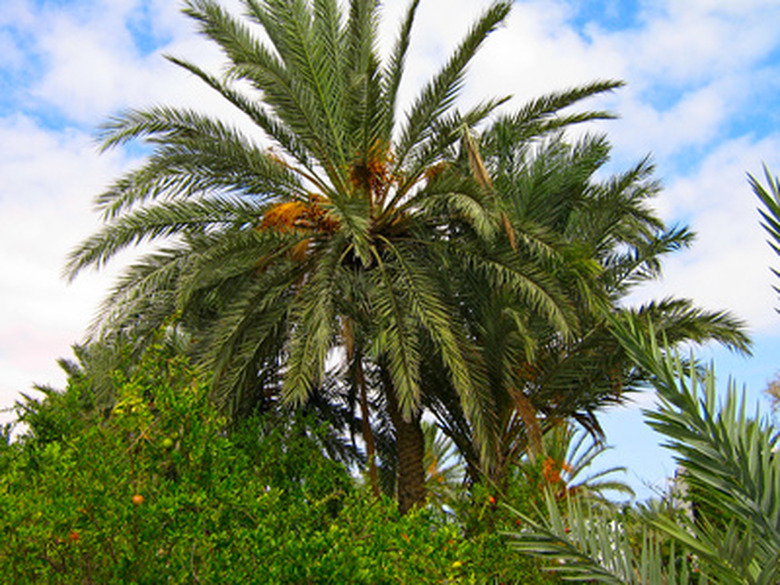Canary Date Palm Diseases
The Canary Island date palm, Phoenix canariensis, can grow 30 to 60 feet in height, with fronds that can reach 18 feet in length. This is the palm tree with the diamond-patterned bark that you will see growing in Las Vegas, California, Florida, Arizona and along the Gulf of Mexico. Although the tree thrives in a Mediterranean climate, it is subject to disease in moist, humid environments.
Fusarium Wilt
Fusarium wilt is responsible for the death of many Canary Island date palms and is, in fact, one of the most destructive of all palm diseases in the state of California, according to James Downer of the University of California Cooperative Extension system. There is no cure for fusarium wilt, which is a fungal disease. This disease spreads primarily through pruning equipment. If equipment is not properly cleaned and sterilized after each use on an infected tree, the fungus will be rapidly transmitted to subsequently pruned trees. According to scientists at the University of Florida, the disease interferes with the xylem, or water conduction system, of the tree, resulting in death. Symptoms of the disease begin with the dying off of the lower leaves of the plant, which turn yellow and then brown. Interestingly, when the disease first becomes evident, only one-half of the leaf appears to die, but eventually the entire leaf will be destroyed.
- The Canary Island date palm, Phoenix canariensis, can grow 30 to 60 feet in height, with fronds that can reach 18 feet in length.
- According to scientists at the University of Florida, the disease interferes with the xylem, or water conduction system, of the tree, resulting in death.
Bud Rot
Although there are several pathogens that can cause bud rot, Phytophthora palmivora is generally the culprit, according to researchers at the University of Florida, who believe that P. palmivora is spread through the soil, improperly sanitized gardening tools and storm water, and then transmitted to the Canary Island date palm through wounds in its bark. Unfortunately, by the time symptoms manifest, it is too late to save the tree. These symptoms include buds that fall over, have a foul odor, or rot at the base. If you suspect that your Canary Island date palm may have bud rot, it is important to take an infected portion to your county cooperative extension agent for a diagnosis and instructions on how to keep the disease from spreading to other plants.
Trunk Rot
Trunk rot is another fungal disease, this one caused by Thielaviopsis paradoxa, which infects the palm through an open wound in its bark. T. paradoxa is transmitted by spores on the wind or in water. Researchers at the University of Florida claim that trunk rot is symptomized by the collapse of the trunk of a seemingly healthy palm, or the canopy falling off the tree. Some palms may appear to be bleeding at the wound site. Cutting out the wounded area may help alleviate this disease. A fungicide labeled for Thielaviopsis diseases should be applied after removal of the wounded area. Clean all equipment used on infected trees by soaking them in three parts of water mixed with one part household bleach.
- Although there are several pathogens that can cause bud rot, Phytophthora palmivora is generally the culprit, according to researchers at the University of Florida, who believe that P. palmivora is spread through the soil, improperly sanitized gardening tools and storm water, and then transmitted to the Canary Island date palm through wounds in its bark.
